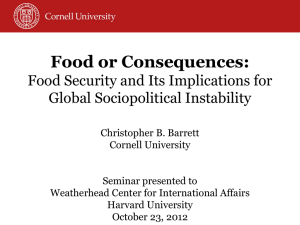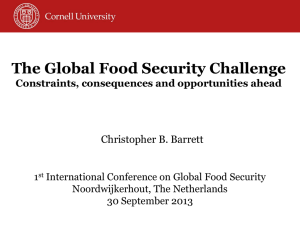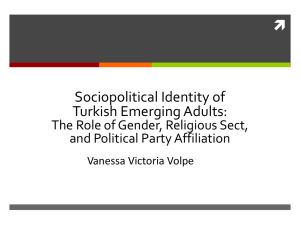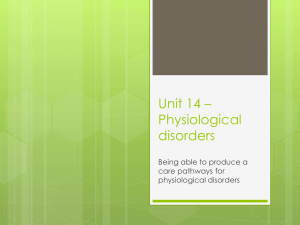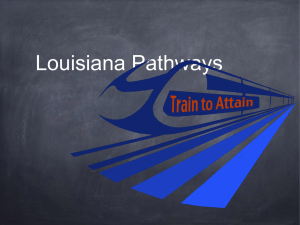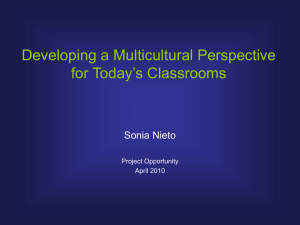Food Security and Its Implications for Global
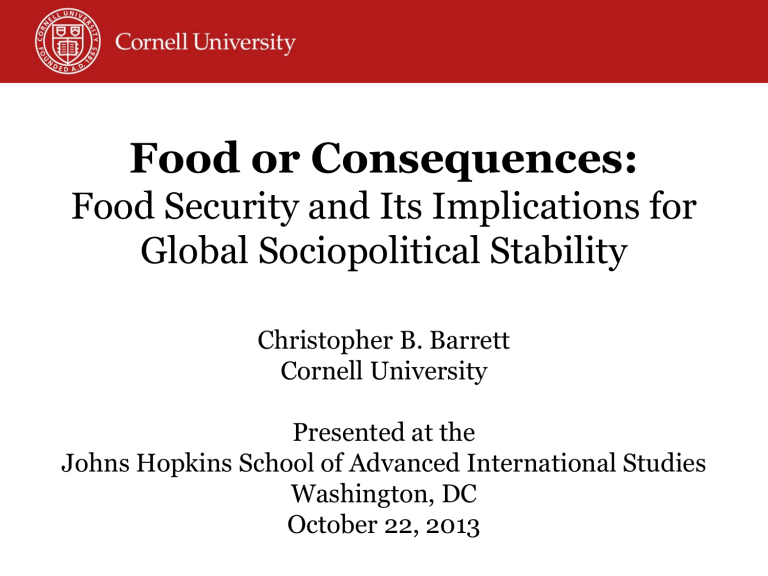
Food or Consequences:
Food Security and Its Implications for
Global Sociopolitical Stability
Christopher B. Barrett
Cornell University
Presented at the
Johns Hopkins School of Advanced International Studies
Washington, DC
October 22, 2013
Background
Food systems successes in 1940s-80s enabled dramatic poverty reduction and improved standards of living
>6(~5) bn people have adequate calories (macro- and micronutrients) today, up from only about 2 billion 50 years ago.
Public/private ag research and policy reforms (esp. in Brazil and China) led to productivity growth far outpacing demand growth, increasing land/water efficiency use and steadily/ sharply lowering real food prices through mid-2000s. This progress lifted hundreds of millions from poverty.
Successes enabled population growth, urbanization and income growth over the “Long Peace” of the late 20 th century
… and induced a dangerous complacency.
Background
Complacency led to underinvestment. Food output growth slowed relative to demand growth. Result: higher food prices and spikes.
FAO Real Food Price Index
250 25
200
150
20
15
10
100
50
5
0
OECD/IFPRI/FAO all forecast food prices 5-20% higher than
2012 levels for the next decade as demand growth continues to outpace supply expansion worldwide.
Social unrest
High Food Prices Associated w/ Social Unrest
Food Prices and Food Riots (Death Tolls)
High food prices associated w/ social unrest/ food riots
(Bellemare 2011, Lagi et al. 2011,
Arezki & Brueckner 2012).
Many gov’ts think of food security as low/stable staple food prices ... ‘urban bias’.
But omitted factors matter a lot in this association.
Source: Lagi et al. (2011)
Food security worries can spark public protest when mixed with a sense of broader injustices.
Social unrest
High Food Prices Also Spark Resource Grabs
High food prices also spur – and reflect – demand for land, water, genetic material, etc.
‘Land grabs’ can help sow domestic discontent
Ex: Madagascar 2008/9
Resource grabs can feed other international tensions, too:
- Marine fisheries
- Water
- ‘Gene grabs’/IP anti-commons
- Oil and minerals
An unclear relationship
The food security-sociopolitical stability relationship remains poorly understood and oft-oversimplified.
Inferential challenge: Correlated common drivers (e.g., climate, land/water competition, large-scale migration) make it difficult to tease out causal links.
Sociopolitical crisis is clearly a cause of food insecurity (e.g.,
Somalia, DRC)… but it increasingly seems a consequence as well.
Don’t really need more causes to seek peace. But need extra push in favor of sensible food security strategies.
Especially important b/c key food security stressors include gov’t, firm and donor policy responses intended to foster food security, but that also have important, adverse spillover effects.
New Book on Topic
This overview summarizes a few key cross-cutting points that emerge from a new collection of papers.
New Book on Topic
18 chapters by leading international experts
Overview (Barrett)
Global food economy (Rosegrant et al)
Climate (Cane & Lee)
Thematic chapters:
Land (Deininger)
Freshwater resources (Lall)
Marine resources (McClanahan et al.)
Crop techs (McCouch & Crowell)
Livestock techs (McDermott et al.)
Labor migration (McLeman)
Trade (Anderson)
Humanitarian assistance (Maxwell)
Geographic chapters:
Latin America (Wolford & Nehring)
Sub-Saharan Africa (Barrett&Upton)
M.East / N.Africa (Lybbert&Morgan)
W.Asia/EC Europe (Swinnen&Herck)
South Asia (Agrawal)
China (Christiaensen)
East Asia (Timmer)
4 key pathways
There are 4 main pathways by which food security might impact sociopolitical stability:
1. Food price spikes and urban unrest: Spontaneous (largelyurban) sociopolitical instability due to food price shocks, with urban food consumers the primary agitators.
But price shocks largely proximate, not root, causes of sociopolitical unrest. Sources are pre-existing grievances and lack of adequate social safety nets or government policies to buffer the effects of market shocks.
High prices can unite/mobilize the already-angry vs. the state or ethnic minorities (e.g., food traders) perceived to hold/exercise power unjustly.
But food plays more of a symbolic/subjective than a substantive role. The issue is less the economic welfare impacts on the poor, than the psychosocial ones of disrupting trust and the fabric of economic and sociopolitical relationships.
4 key pathways
There are 4 main pathways by which food security might impact sociopolitical stability:
2. Intensified competition for rural resources: Slower-evolving, structural pressures due to (largely rural) intra- and interstate resource competition over land, water, fisheries, labor, capital and the byproducts of such competition (e.g., chaotic internal migration, outbreaks of zoonoses, etc).
Farmers/farm workers the main agitators, although international NGOs/ firms are important external agents (e.g., over GMOs, “land grabs”, etc.).
Typically unrest about distributional questions and power. More likely to mutate into social and/or guerilla movements than is urban unrest from price shocks. Exploitable by pre-existing opposition movements.
4 key pathways
There are 4 main pathways by which food security might impact sociopolitical stability:
3. Improving technologies and technical efficiency:
Historically, technical change has permitted supply expansion without intensified competition for resources.
Growing disparities in rates of technical change in agriculture. Investment is least where yield gaps and anticipated demand growth are greatest.
Dramatic changes in the competitive landscape – especially as intellectual property regimes increasingly impede rather than foster progress.
Controversial (GM) technologies create new areas of contestation
Technological change is no panacea. But there seem few options for progress without re-acceleration of agricultural technological change, especially in Africa and Asia.
4 key pathways
There are 4 main pathways by which food security might impact sociopolitical stability:
4. Policy interventions to temporarily augment supply: States address pressures through policies that reallocate food across time (buffer stock releases), space (trade barriers), or people (social protection). These often have unintended, beggar-thy-neighbor consequences.
None of these policies increases food supply; they merely reallocate it.
Commonly exports the food security stress to other (sub)populations.
Breed dangerous complacency by suggesting that quick fixes can substitute for longer-term, structural investments to enable supply growth to keep pace with demand expansion.
Need social protection closely coupled with productivity growth.
The reasonable hypothesis that food insecurity can spark sociopolitical unrest adds a key reason to redouble efforts to stimulate ag productivity growth coupled with effective social protection measures.
But must focus on
Africa and Asia!
Food or consequences
Looking forward
Past success proves the potential of food systems to reduce human suffering and maintain social stability.
This challenge can be met. But structural demand and supply patterns for food pose major challenges.
Climate change, growing land/water scarcity, more complex IP regimes and OECD macroeconomic stress make it harder now than it was in the 1940s-80s.
Failure to meet this challenge may lead not just to widespread food insecurity, but also to social unrest, magnifying unnecessary human suffering.
Must focus most attention where the challenges and the risks will be greatest : in Africa and Asia.
Looking forward
But the means by which food security is achieved, and for whom, matters fundamentally to the relationship between food security and sociopolitical stability.
Food security achieved via greater productivity per worker/ha/m 3 , reduced post-harvest loss, improved food distribution systems and/or social protection policies directly reduces sociopolitical instability.
Conversely, local food security achieved through measures that have adverse spillover effects – increased natural resources exploitation or beggarthy-neighbor trade, market, NRM, or IP policies – can have adverse sociopolitical effects that ultimately aggravate underlying food security stress.
